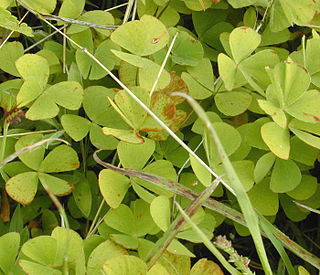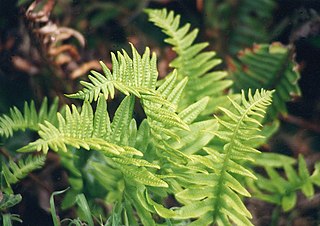Related Research Articles

Vascular plants, also called tracheophytes or collectively Tracheophyta, form a large group of land plants that have lignified tissues for conducting water and minerals throughout the plant. They also have a specialized non-lignified tissue to conduct products of photosynthesis. Vascular plants include the clubmosses, horsetails, ferns, gymnosperms, and angiosperms. Scientific names for the group include Tracheophyta, Tracheobionta and Equisetopsida sensu lato. Some early land plants had less developed vascular tissue; the term eutracheophyte has been used for all other vascular plants, including all living ones.

Osmunda is a genus of primarily temperate-zone ferns of family Osmundaceae. Five to ten species have been listed for this genus.

Equisetales is an order of subclass Equisetidae with only one living family, Equisetaceae, containing the genus Equisetum (horsetails).

The order Salviniales is an order of ferns in the class Polypodiopsida.

The Dryopteridaceae are a family of leptosporangiate ferns in the order Polypodiales. They are known colloquially as the wood ferns. In the Pteridophyte Phylogeny Group classification of 2016 (PPG I), the family is placed in the suborder Polypodiineae. Alternatively, it may be treated as the subfamily Dryopteridoideae of a very broadly defined family Polypodiaceae sensu lato.

The order Cyatheales, which includes most tree ferns, is a taxonomic order of the fern class, Polypodiopsida. No clear morphological features characterize all of the Cyatheales, but DNA sequence data indicate the order is monophyletic. Some species in the Cyatheales have tree-like growth forms from a vertical rhizome, others have shorter or horizontal expanding rhizomes.

Salviniaceae, is a family of heterosporous ferns in the order Salviniales. The Salviniaceae contain the two genera Azolla and Salvinia, with about 20 known species in total. The oldest records of the family date to the Late Cretaceous. Azolla was previously placed in its own family, Azollaceae, but research has shown Azolla and Salvinia to be sister genera with the likely phylogenic relationship shown in the following diagram.

The order Polypodiales encompasses the major lineages of polypod ferns, which comprise more than 80% of today's fern species. They are found in many parts of the world including tropical, semitropical and temperate areas.

A pteridophyte is a vascular plant that disperses spores. Because pteridophytes produce neither flowers nor seeds, they are sometimes referred to as "cryptogams", meaning that their means of reproduction is hidden. Ferns, horsetails, and lycophytes are all pteridophytes. However, they do not form a monophyletic group because ferns are more closely related to seed plants than to lycophytes. "Pteridophyta" is thus no longer a widely accepted taxon, but the term pteridophyte remains in common parlance, as do pteridology and pteridologist as a science and its practitioner, respectively. Ferns and lycophytes share a life cycle and are often collectively treated or studied, for example by the International Association of Pteridologists and the Pteridophyte Phylogeny Group.

Diplazium esculentum, the vegetable fern, is an edible fern found throughout Asia and Oceania. It is probably the most commonly consumed fern.

Pteridaceae is a family of ferns in the order Polypodiales, including some 1150 known species in ca 45 genera, divided over five subfamilies. The family includes four groups of genera that are sometimes recognized as separate families: the adiantoid, cheilanthoid, pteridoid, and hemionitidoid ferns. Relationships among these groups remain unclear, and although some recent genetic analyses of the Pteridales suggest that neither the family Pteridaceae nor the major groups within it are all monophyletic, as yet these analyses are insufficiently comprehensive and robust to provide good support for a revision of the order at the family level.

Athyrium (lady-fern) is a genus of about 180 species of terrestrial ferns, with a cosmopolitan distribution. It is placed in the family Athyriaceae, in the order Polypodiales. Its genus name is from Greek a- ('without') and Latinized Greek thyreos ('shield'), describing its inconspicuous indusium . The common name "lady fern" refers in particular to the common lady fern, Athyrium filix-femina.

Harald Ingemann Nielsen was a Danish footballer who played as a forward. He played professionally for Italian club Bologna F.C. where he was the league top scorer (capocannoniere) in Bologna's 1964 Serie A championship winning season. Harald Nielsen played 14 games for the Denmark national team in 1959 and 1960, scoring 15 goals, and he was known as Guld-Harald (Gold-Harald). He was a football entrepreneur having continuously worked for the professionalization of both the Danish national team and the national league.

Saccolomataceae is a family of ferns in the order Polypodiales with about 19 species. It has been formerly treated as part of the Dennstaedtiaceae, however it has been classified as its own family according to Smith et al. (2006) The genus Saccoloma has been classified to include Orthiopteris, but the phylogeny of the group not yet fully understood. The family includes a dozen known species.

The euphyllophytes are a clade of plants within the tracheophytes. The group may be treated as an unranked clade, a division under the name Euphyllophyta or a subdivision under the name Euphyllophytina. The euphyllophytes are characterized by the possession of true leaves ("megaphylls"), and comprise one of two major lineages of extant vascular plants. As shown in the cladogram below, the euphyllophytes have a sister relationship to the lycopodiophytes or lycopsids. Unlike the lycopodiophytes, which consist of relatively few presently living or extant taxa, the euphyllophytes comprise the vast majority of vascular plant lineages that have evolved since both groups shared a common ancestor more than 400 million years ago. The euphyllophytes consist of two lineages, the spermatophytes or seed plants such as flowering plants (angiosperms) and gymnosperms, and the Polypodiophytes or ferns, as well as a number of extinct fossil groups.

The Kunsthalle Bern is a Kunsthalle on the Helvetiaplatz in Bern, Switzerland.
Cystodium is a fern in its own family, Cystodiaceae. It contains a single species: Cystodium sorbifolium(Sm.) J.Sm. 1841. Because it looks like a small tree fern, it had previously been placed in the tree fern family Dicksoniaceae. Subsequent analysis had moved it to the Lindsaeaceae, but the most recent phylogenetic studies have placed it in its own separate family, Cystodiaceae, with a sister relationship to the current Lindsaeaceae. A fossil species of the genus Cystodium sorbifolioides is known from the Cenomanian aged Burmese amber in Myanmar.

The Dipteridaceae is a family of ferns in the order Gleicheniales of the class Polypodiopsida. They are commonly known as umbrella ferns and contain two genera, Cheiropleuria and Dipteris, with a total of nine species confined to Asia, New Guinea and northern Australia While currently a small family, they were much more abundant in the Mesozoic era, with the oldest fossils being known from the Middle Triassic of Italy, Australia and Argentina. Seven fossil genera are recognised, including Hausmannia, Clathropteris, Dictyophyllum, Thaumatopteris, Camptopteris, and Polyphacelus.

Ophioglossidae is one of the four subclasses of Polypodiopsida (ferns). This subclass consists of the ferns commonly known as whisk ferns, grape ferns, adder's-tongues and moonworts. It is equivalent to the class Psilotopsida in previous treatments, including Smith et al. (2006). The subclass contains two orders, Psilotales and Ophioglossales, whose relationship was only confirmed by molecular phylogenetic studies.

Lindsaeineae is a suborder of ferns (Polypodiopsida), order Polypodiales, created by the Pteridophyte Phylogeny Group (2016). It consists of two monogeneric families plus the larger Lindsaeaceae with seven genera, and the suborder contains about 237 species overall. It corresponds to Lindsaeaceae sensu Smith 2016.
References
- ↑ Harald Schneider at WorldFootball.net
- ↑ Harald Schneider at National-Football-Teams.com